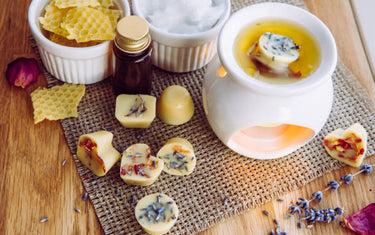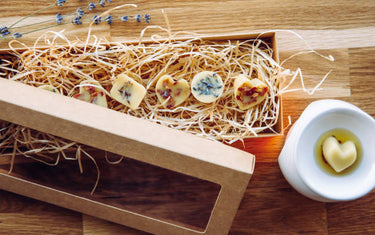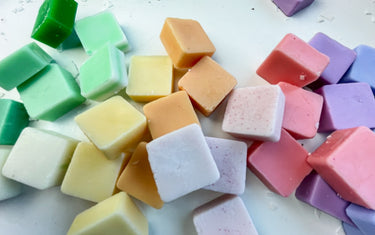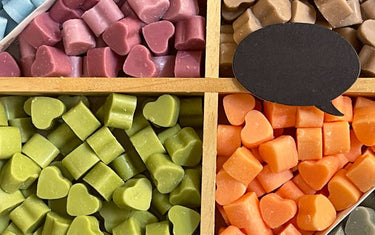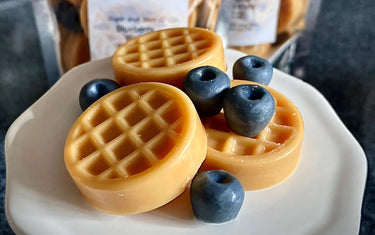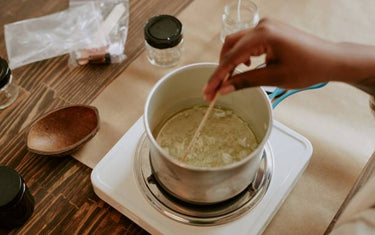5 min read / 24 February 2025 / yasmin sharp
7. How to Create a Wax Melt Brand
Learn how to develop successful wax melts with tips on branding, packaging, quality control, pricing, and marketing strategies to boost your sales.
Share this post

So, you want to develop your own wax melts? Developing a successful wax melts product requires a comprehensive approach.
Key elements include branding, packaging design, testing, quality control, pricing, and marketing strategies. Each aspect plays an important part in creating a product that stands out in a very competitive wax melts market.
In this blog, you'll gain a better understanding of these aspects and how you can effectively implement these elements to set your wax melts apart.
First, let’s start with branding and packaging design.

Branding and Packaging Design
Defining Your Wax Melts Branding
To stand out in the wax melts market you'll need to create a unique brand identity. This will help you to attract customers and build loyalty over time.
Your brand should resonate with your target audience, reflecting their values and preferences. Here are some key considerations for your wax melts branding:
- Audience Demographics: Think about who your customers are in detail. Consider factors such as their age, gender, lifestyle, and purchasing habits. For example, are your customers predominantly younger individuals looking for trendy scents, or are they older consumers seeking nostalgic fragrances?
- Values and Preferences: Understand what matters to your audience. Is it eco-friendliness, luxury, or affordability? For example, if your target market values sustainability, highlighting eco-friendly materials in your product will resonate well with them.
Your brand's tone, imagery, and overall message should align with what your audience values. This consistency will help make your brand more memorable and relatable.
Creating Memorable Wax Melt Packaging
Effective wax melt packaging design will help protect your products and is a chance to make a memorable impact. Consider the following elements in your wax melt packaging:
- Visual Appeal: Use colour schemes, fonts, and imagery that reflect your brand ethos.
- Sustainability: Explore eco-friendly options for packaging materials. Customers increasingly appreciate brands that prioritise sustainability.
- Unboxing Experience: Think about how the packaging will feel to customers. Including thoughtful touches, such as a personalised thank-you note will help your products to feel more personable.
You should also make sure you know how to pack wax melts correctly to avoid any potential damage or mishaps.
Example of Wax Melt Packaging Styles
When considering your wax melts packaging ideas, think about the different styles available:
- Minimalistic Packaging: Utilises simple designs, limited colours, and clean fonts. This style appeals to a modern audience and communicates sophistication.
- Luxury Packaging: Employs premium materials, elaborate designs, and attention to detail. This approach is ideal for high-end products targeting affluent consumers.
- Eco-Friendly Packaging: Made from sustainable materials, this style emphasises environmental consciousness and attracts eco-conscious buyers.
By selecting a packaging style that aligns with your brand identity, you can significantly impact how consumers perceive your product.

Testing and Quality Control
Product Formulation Testing
Creating the perfect wax melt means you must rigorously test your formulations. You should evaluate the following aspects to make sure the quality of your product is up to scratch.
- Fragrance Strength: Ensure that the scent is strong enough to meet customer expectations. Conduct blind tests with potential customers to gauge their reactions to different fragrances.
- Melting Time: Test how long the wax melts last when in use. This can significantly affect customer satisfaction. Ensure that your product burns consistently and effectively.
- Safety: Adhere to safety standards to protect consumers. Conduct thorough testing on all ingredients to ensure they are safe for use in homes.
Experiment with various wax types, such as soy, paraffin, and beeswax, alongside different fragrance oils. This experimentation will help you find the ideal balance that appeals to your audience. Solicit customer feedback during this phase, as it is invaluable for refining your product.
Quality Control Measures
Another key area for wax melt development is the ability to maintain consistency across your batches, as it will help to foster a sense of customer loyalty and turn them into repeat customers.
Consider implementing the following quality control measures:
- Scent Consistency: Regularly test to ensure each batch has the same fragrance strength.
- Appearance: Each wax melt should look uniform in colour and shape. This aspect contributes to your overall brand perception.
- Performance Standards: Monitor melting temperatures and comply with safety regulations, such as CLP labels.
High-quality standards will help you to build both brand trust and loyalty — the key to a successful business.

Pricing and Marketing Strategies
Pricing Models
Knowing how to price your wax melts can feel tricky. How do you find that sweet spot?
To price your wax melts appropriately, consider these factors:
- Production Costs: Calculate all costs associated with production, including materials, labour, and overheads. Understanding your cost structure will help you determine a profitable price point.
- Branding: Your wax melts branding can justify a premium price point. High-quality packaging and unique fragrances can allow for higher pricing.
- Competitor Analysis: Research what similar products are priced at to find your competitive edge. Consider conducting market surveys to understand what your customers are willing to pay.
Explore different pricing strategies, such as value-based pricing, which considers what customers are willing to pay, or competitive pricing, which focuses on market rates. A well-thought-out pricing strategy can significantly affect your sales and profitability.
Marketing and Sales Channels
Your marketing strategy will largely determine your product's reach and success. Here are some different avenues you could explore:
- Online Sales: Setting up an e-commerce platform for your wax melts is a good option, combined with SEO strategies to garner a wider reach. Creating a user-friendly website will also encourage more purchases.
- Brick-and-Mortar Stores: Explore partnerships with local shops or boutiques to sell your products. Having a physical presence can enhance brand awareness.
- Social Media: Social media platforms are a great way to stay in touch with your customer base. Use visually appealing posts to showcase your wax melts. Influencer partnerships can also expand your reach by tapping into established audiences.
Storytelling is vital in marketing. You should build a narrative around your brand that resonates with customers' emotions and lifestyle aspirations. Share your journey, values, and the unique aspects of your wax melts. This personal touch can help to nurture customer engagement.
Seasonal and Special Promotions
Leveraging seasonal trends, such as making Christmas-themed wax melts, can help you to drive sales and give customer engagement a boost. Here are some ideas you could consider:
- Holiday Scents: Create special editions like Christmas wax melts. Tailor your marketing efforts around these seasonal offerings to attract customers during peak shopping times.
- Promotional Bundles: Offer bundles or subscription services to encourage repeat purchases and customer loyalty. This approach not only boosts sales but also creates a sense of exclusivity.
Limited-time releases can create urgency, prompting customers to buy before they miss out. Email marketing is a great way to do this.

In Summary
By focusing on these areas during your wax melt development, you can create a product that meets customer expectations and stands out in a competitive market.
If you’re looking to make wax melts in batches, consider signing up for a Nikura wholesale account. You’ll get access to exclusive discounts and deals to help you to save money in the long run.


